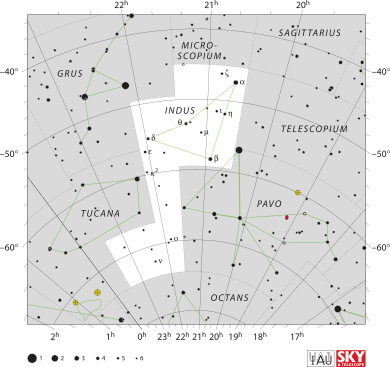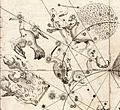Indus (constellation) facts for kids
| Constellation | |

List of stars in Indus
|
|
| Abbreviation | Ind |
|---|---|
| Genitive | Indi |
| Pronunciation | genitive |
| Symbolism | the Indian |
| Right ascension | 21 |
| Declination | −55 |
| Quadrant | SQ4 |
| Area | 294 sq. deg. (49th) |
| Main stars | 3 |
| Bayer/Flamsteed stars |
16 |
| Stars with planets | 3 |
| Stars brighter than 3.00m | 0 |
| Stars within 10.00 pc (32.62 ly) | 1 |
| Brightest star | The Persian (α Ind) (3.11m) |
| Messier objects | none |
| Meteor showers | none |
| Bordering constellations |
Microscopium Sagittarius (corner) Telescopium Pavo Octans Tucana Grus |
| Visible at latitudes between +15° and −90°. Best visible at 21:00 (9 p.m.) during the month of September. |
|
The Indus constellation is a group of stars in the southern sky. It looks like a figure of a person. This constellation is named after the word "Indian." It represents the native people of the Americas or East India.
Indus is one of the 88 modern constellations. It is a fairly small constellation. It ranks 49th in size among all constellations.
Contents
Discovering the Indus Constellation
Indus was first mapped in the late 1500s. It was created by Dutch navigators Pieter Dirkszoon Keyser and Frederick de Houtman. They explored the southern seas. During their voyages, they charted many new stars. These stars were not visible from Europe.
The constellation first appeared in a star atlas in 1603. This atlas was called Uranometria. It was made by the German astronomer Johann Bayer. He used the observations from Keyser and Houtman.
Finding Indus in the Sky
Indus is located in the fourth quarter of the southern hemisphere. This means you can only see it from the Southern Hemisphere. It is best viewed in September.
Indus is surrounded by several other constellations. These include Microscopium, Telescopium, and Pavo. It also borders Octans, Tucana, and Grus. Knowing these nearby constellations can help you find Indus.
Bright Stars in Indus
Even though Indus is not very bright, it has some interesting stars. The brightest star in Indus is called Alpha Indi. It is also known as "The Persian." This star shines with a magnitude of 3.11.
Another notable star is Epsilon Indi. This star is quite close to Earth. It is only about 11.83 light-years away. A light-year is the distance light travels in one year. This is a huge distance, but it's close in space terms!
Deep-Sky Objects in Indus
Deep-sky objects are things in space beyond our solar system. They include galaxies, nebulae, and star clusters. Indus contains a few of these fascinating objects.
- NGC 7049: This is a galaxy. It looks like a giant spiral of stars.
- NGC 7090: This is another galaxy. It is also a spiral galaxy.
These galaxies are very far away. They are made of billions of stars. Studying them helps astronomers learn about the universe.
Images for kids
-
Indus (top middle) in an extract from Johann Bayer's Uranometria, its first appearance in a celestial atlas.
See also
 In Spanish: Indus (constelación) para niños
In Spanish: Indus (constelación) para niños


